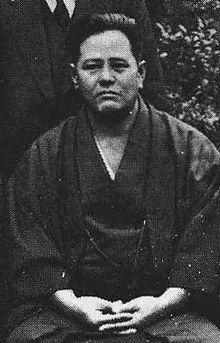Gojū Ryū

Gōjū-ryū founder Chōjun Miyagi.
|
|
| Date founded | c.1930 |
|---|---|
| Country of origin | Okinawa (Japan) |
| Founder | Chōjun Miyagi (宮城 長順?), 1888–1953) |
| Current head |
In alphabetical order: |
| Arts taught | Karate |
| Ancestor schools | Naha-te • Shaolin Nam Pai Chuan • Fujian White Crane |
| Descendant schools | Kyokushin • Isshin-ryū |
In alphabetical order:
(1) Gōjū-Kai / Gōgen Yamaguchi, founder; Goshi Yamaguchi.
(2) IOGKF /Morio Higaonna, founder; Tetsuji Nakamura.
(3) Jinbukan, Katsuyoshi Kanei, founder;
(4) Jundokan International / Teruo Chinen, founder.
(5) Jundokan Okinawa / Eiichi Miyazato, founder; Tetsonuke Yasuda.
(6) Kenshikai / Tetsuhiro Hokama, founder.
(7) Ken-Shin-Kan / Seiichi Yoshikata Akamine, founder; Raul Fernandez de la Reguera.
(8) Okinawa Gojuryu Kenkyukai / Masaji Taira
(9) Okinawa-Kan / Kiichi Nakamoto.
(10) Seigokan Gōjū-ryū / Seigo Tada, founder.
(11) Seito Gōjū-ryū / Kanki Izumikawa, founder.
(12) Sengukan / Seiko Fukuchi and Kanki Izumikawa, founder.
(13) Shobukan / Masanobu Shinjo, founder; Seiki Takushi and John Porta.
(14) Shodokan / Seiko Higa, founder;
(15) Shoreikan / Seikichi Toguchi, founder.
(16) Yuishinkan/Tomoharu Kisaki
(17) Meibukan / Meitoku Yagi, founder; Meitatsu Yagi
Gōjū-ryū (剛柔流?), Japanese for "hard-soft style," is one of the main traditional Okinawan styles of karate, featuring a combination of hard and soft techniques. Both principles, hard and soft, come from the famous martial arts book used by Okinawan masters during the 19th and 20th centuries, the Bubishi (Chinese: 武備志; pinyin: Wǔbèi Zhì).Gō, which means hard, refers to closed hand techniques or straight linear attacks; jū, which means soft, refers to open hand techniques and circular movements. Gōjū-ryū incorporates both circular and linear movements into its curriculum, combining hard striking attacks such as kicks and close hand punches with softer open hand circular techniques for attacking, blocking, and controlling the opponent, including locks, grappling, takedowns and throws.
...
Wikipedia
